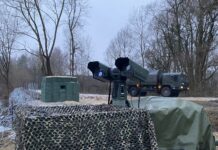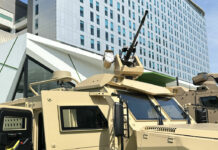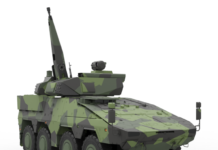As the threat from unmanned aerial vehicles (UAV) grows, Counter-UAV (C-UAV or CUAV) capabilities are becoming a vital subsector of modern armed forces’ air defence arm.
The ongoing war in the Ukraine has seen a significant deployment of unmanned systems by both belligerents. This development was presaged over the past decade by events in the Middle East, where Iraqi insurgents weaponised civilian UAVs, and Houthi rebels launched sophisticated long-range drone strikes against Saudi energy facilities. Globally, nation states are deploying UAVs across the size- and mission-spectrum, ranging from rucksack-portable personal reconnaissance systems to long-range, high-endurance surveillance and strike aircraft. Smaller drones are of particular concern. They are difficult to detect, can be deployed in large numbers (either dispersed to cover a wide area, or as a swarm to overwhelm defences), and are much cheaper than manned aircraft. All of these characteristics pose considerable challenges to the C-UAV mission.
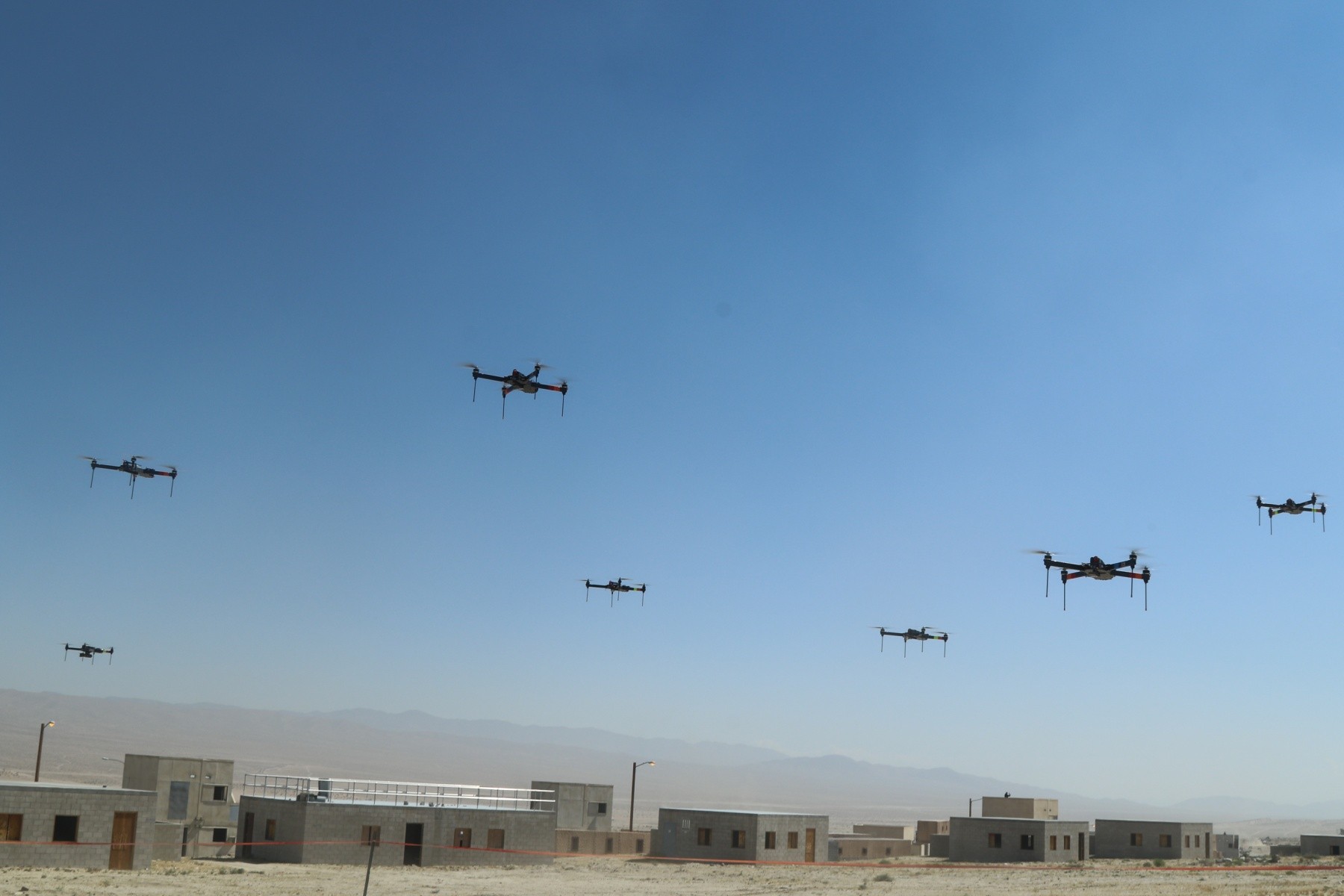
Credit: US Army
The US armed forces (among others) have been developing and adapting their C-UAV strategy, tactics and hardware in order to stay ahead of the threat. Each service is pursuing tactics and weapon systems optimised to their own operational priorities. Since large UAVs tend to have a similar profile to manned aircraft, much of the targeted research is geared toward the Small UAV (sUAV) threat. This would encompass the first two of the five UAV groups classified by the US armed forces. Group 1 UAVs weigh less than nine kg, have an operating ceiling below 366 m, and a maximum airspeed of 51.4 m/s (100 knots).
Corresponding figures for Group 2 UAV are a weight of 9-25 kg, 1,067 m ceiling, and 128.6 m/s (250 knots) airspeed. However, Group 3 or medium UAV (with a weight of <600 kg; 5,487 m service ceiling, and speed of <128.6 m/s (250 knots)) also remain a major concern, not least of all because of their capability to carry significant lethal payloads.
To reduce redundancy, in 2019 the Pentagon appointed the US Army as the executive agent overseeing all Department of Defense (DoD) Counter sUAV (C-sUAV) programs. A Joint Counter-small Unmanned Aircraft Systems Office (JCO) was established in 2020 to coordinate with the joint service combatant commands and the office of the Undersecretary of Defense for Acquisition and Sustainment. The JCO director, US Army Major General Sean Gainey, has underscored the need for a layered, system-of-systems approach to C-UAV operations. No single capability could defeat the spectrum of threats, Gainey stated in February 2023.
Dedicated Air Defence Weapons
High-end air- and missile-defence systems such as Patriot are capable of intercepting UAVs. However, except for neutralising large, high-altitude or very fast unmanned aircraft, they are rarely the optimal choice. Small, low- and slow-flying drones are difficult for high-end systems to locate and impact. As for medium-sized UAVs, there is a significant risk that an adversary would saturate the airspace with comparatively cheap drones in hopes that US forces would expend their stock of expensive air-defence missiles, leaving batteries depleted and ill-equipped to combat follow-on waves of cruise missiles or manned tactical aircraft.
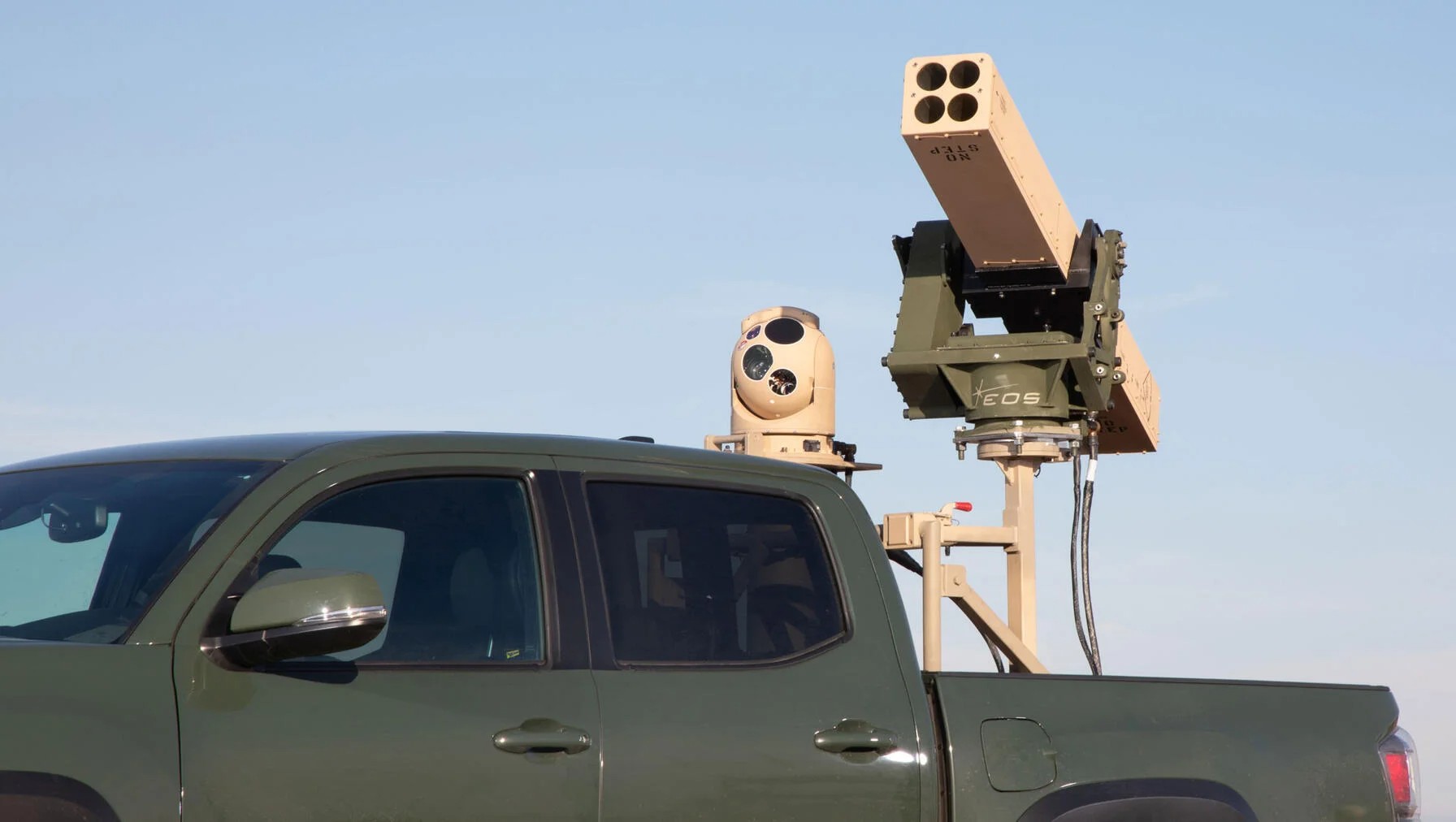
Credit: L3 Harris Technologies
Smaller interceptor systems with lower operating cost are being developed for the C-UAV mission. L3Harris Technologies introduced one such system, dubbed the VAMPIRE (Vehicle Agnostic Modular Palletized ISR Rocket Equipment), at the November 2022 Association of the United States Army (AUSA) conference. The weapons kit, which took two years to develop, consists of a four-cell 70 mm rocket launcher and the WESCAM MX-10 stabilised infrared sighting system. The firm plans to further upgrade the weapon system by adding a radar. According to L3 Harris, the VAMPIRE kit can be mounted on most tactical or commercial-grade vehicles with a suitable flatbed, including pickup trucks. The C-UAV system is controlled by a single operator using a joystick and screen. The laser-guided Advanced Precision Kill Weapon System (APKWS) rocket uses an L3Harris-designed proximity fuze to destroy the target. VAMPIRE is considered a low-cost intercept weapon – depending on the variant, each APKWS costs USD 27,500. This is approximately the same cost as the medium-sized drone being intercepted, or roughly 1% of the cost of high-end interceptor missiles. The kit is currently being supplied to Ukraine’s armed forces by redirecting units ordered under a US Navy prototype contract which predates the Russian invasion of Ukraine.
The US Army has chosen Raytheon’s vehicle-mounted LIDS (Low, slow, small unmanned aircraft system Integrated Defeat System) as a near-term C-UAV solution. LIDS consists of Raytheon’s Coyote unmanned aircraft (upgraded with an active radar seeker and warhead, and deployed as a de facto surface-to-air missile) and either the company’s Ku-band Radio Frequency Sensor (KuRFS) multifunctional radar or its lighter equivalent, the Ku-720. Also integrated into LIDS are Northrop Grumman’s Forward Area Air Defense Command and Control (FAAD C2) system, and an electronic warfare (EW) system made by Syracuse Research Corporation. The weapon system can be mounted on a tactical vehicle or provide point defence as a palletised system. It provides both kinetic and non-kinetic options to neutralise individual armed and reconnaissance drones up to Group 3 UAV as well as UAV swarms. The system’s operational debut came in January 2023 when Coyotes downed two attack drones targeting a US outpost in south-eastern Syria. The Army plans to equip two divisions with LIDS.
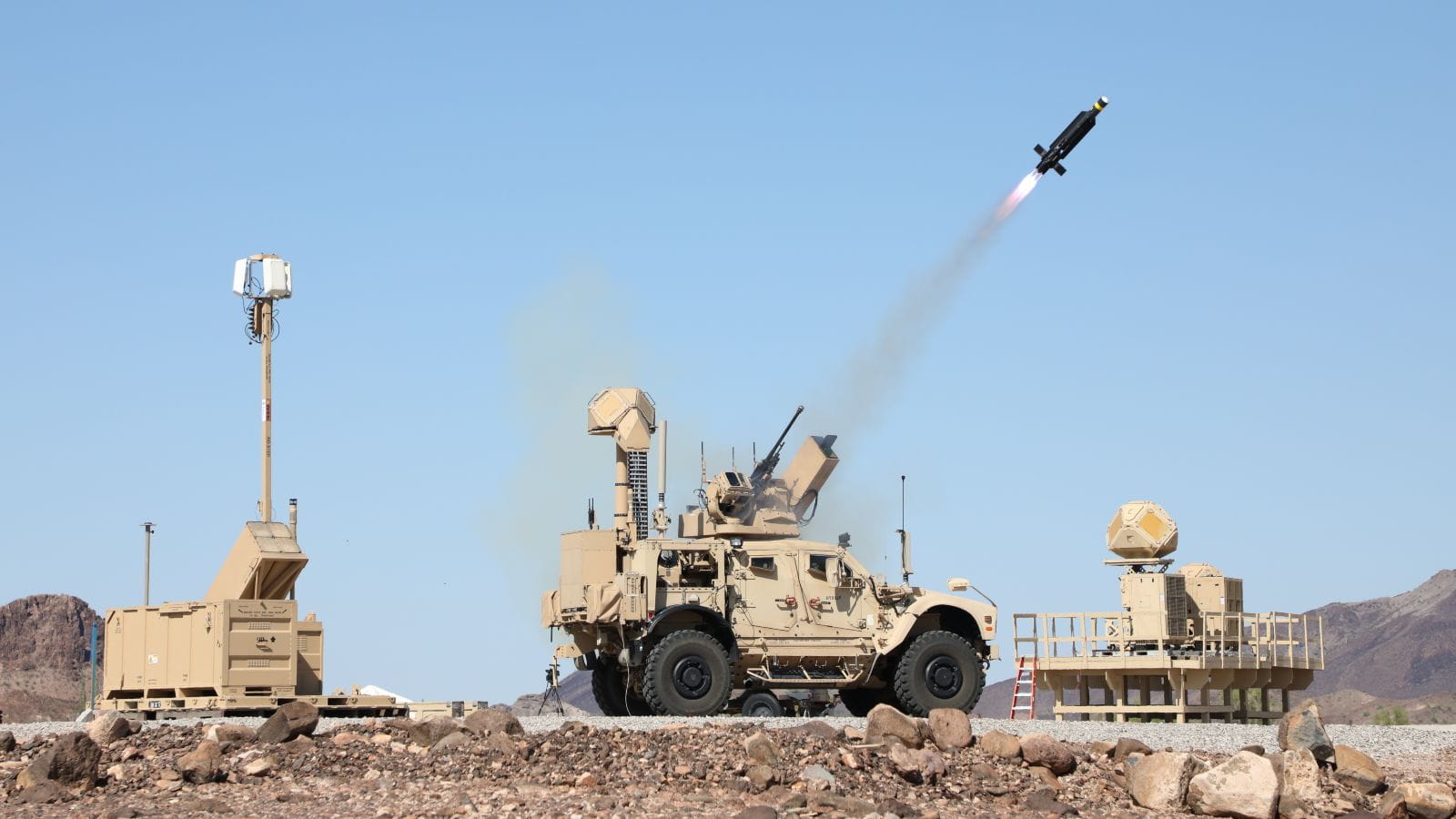
Credit: Raytheon
Small Arms Kinetic Weapons
Standard-issue vehicle-mounted and man-portable guns can be directed against medium-sized to small UAVs at close ranges. The greatest challenge here is acquiring the target. Vehicle-mounted automatic weapons benefit from extra sensors calibrated for the sUAV threat. The US Army is pursuing a variety of initiatives including the Ballistic Low Altitude Drone Engagement system (BLADE). The sensor suite can be integrated with the Common Remotely-Operated Weapon Station (CROWS) carried on a broad range of tactical vehicles. BLADE adds a targeting radar and fire control software to the optical sensors already included on the weapon station, significantly improving the CROWS-mounted machine guns chances of acquiring and destroying small, erratically moving targets.
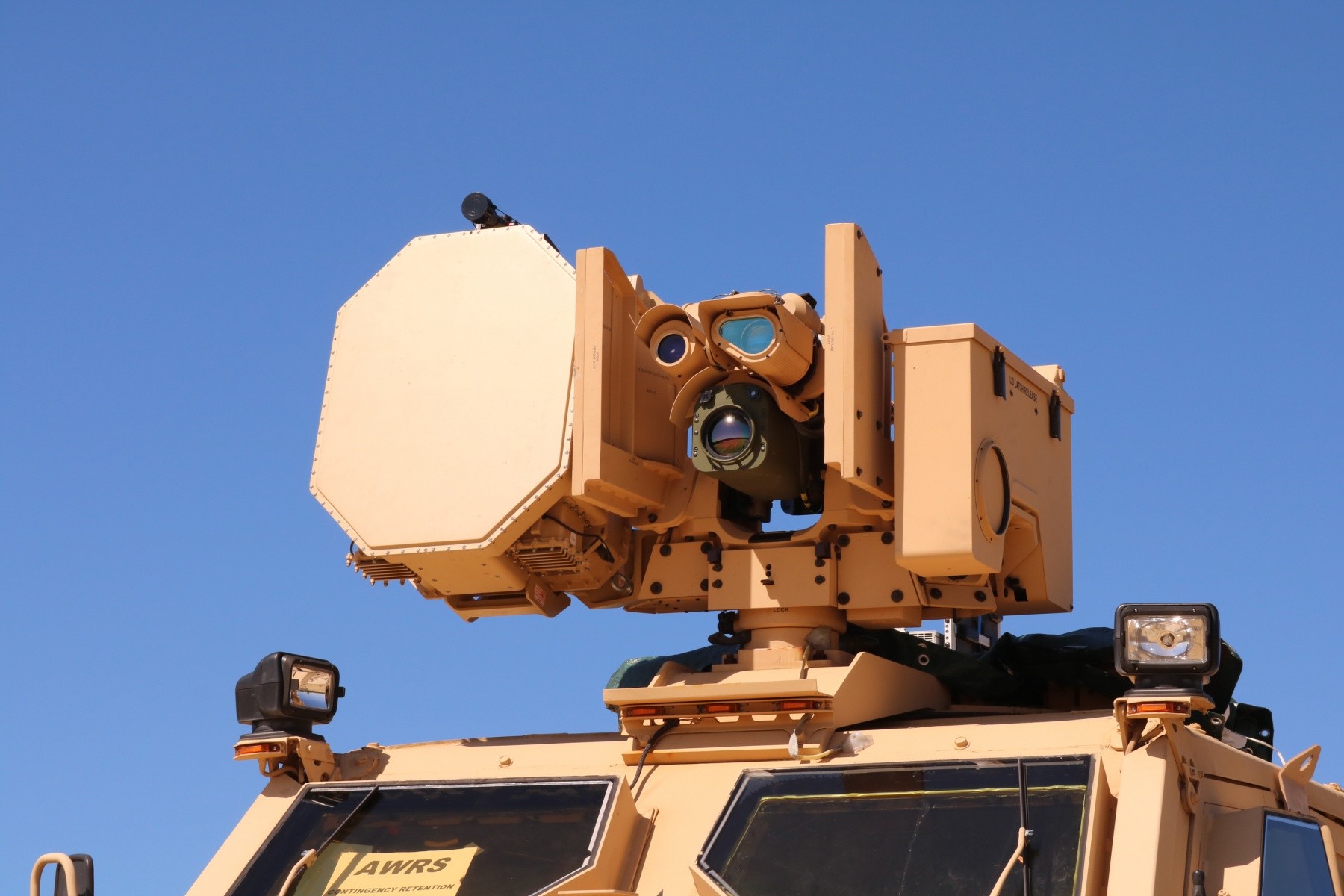
Credit: US Army
In October 2022 the Israeli firm Smart Shooter announced that the US Army had contracted to acquire the SMASH 3000 fire control system, which has also been evaluated by the US Navy, Marine Corps and Special Operations Command. The SMASH 3000 computerised fire control and optic system weighs 740 g and is mounted on standard assault and sniper rifles in place of other scopes or sighting aids. According to the manufacturer, when soldiers aim at a drone the SMASH 3000’s “target acquisition and tracking algorithms […] integrated with sophisticated image-processing software” automatically acquires the target. The processor anticipates the targets movements and continues to track it even as the UAV or the shooter moves. When the system locks onto the target the soldier is instructed to fire. SMASH 3000 is said to enable “one shot, one kill” engagement of small UAVs at up to 200 m distance.
Moving into the medium-calibre side of the spectrum, in October 2022, the Army announced that it was acquiring Northrop Grumman’s XM1211 30mm High Explosive Proximity (HEP) round for deployment on the XM914 chain gun. The XM914 is mounted on a variety of wheeled tactical vehicles including Stryker vehicles. According to Northrop Grumman, the 30×113 mm rounds have been designed specifically to engage UAVs weighing between 9 to 114 kg. Each round is equipped with a radio frequency (RF) proximity fuze. Compared to impact-fuzed and even time-fuzed ammunition, proximity fuzed munitions are expected to significantly enhance lethality against both single and swarm UAVs.
Electromagnetic Weapons
The JCO views directed energy as promising for counter-swarm operations, once the technology reaches maturity. All Electromagnetic (EM) weapons share the advantages of nearly inexhaustible ‘magazines’ and extremely low operating cost per shot. A variety of EM weapon concepts are under consideration for countering small to medium-sized UAVs. These weapons can be divided into three categories: radio-wavelength ‘jammers’, high power microwave (HPM) weapons, and high energy laser (HEL) weapons.
Jammers interrupt the connection between remotely-controlled drones and their operators, forcing the drone to either land or return to its launching point (which has the added benefit of revealing the enemy controller’s position). High power microwave weapons can overload and destroy the microelectronics aboard UAVs. Both jammers and HPMs can cover a significant sector of airspace at any given time, and disable multiple targets simultaneously. On the negative side, HPM energy disperses relatively quickly, constraining effective range. Shielding and electronic countermeasures can also protect UAVs from both Jamming and HPM radiation.
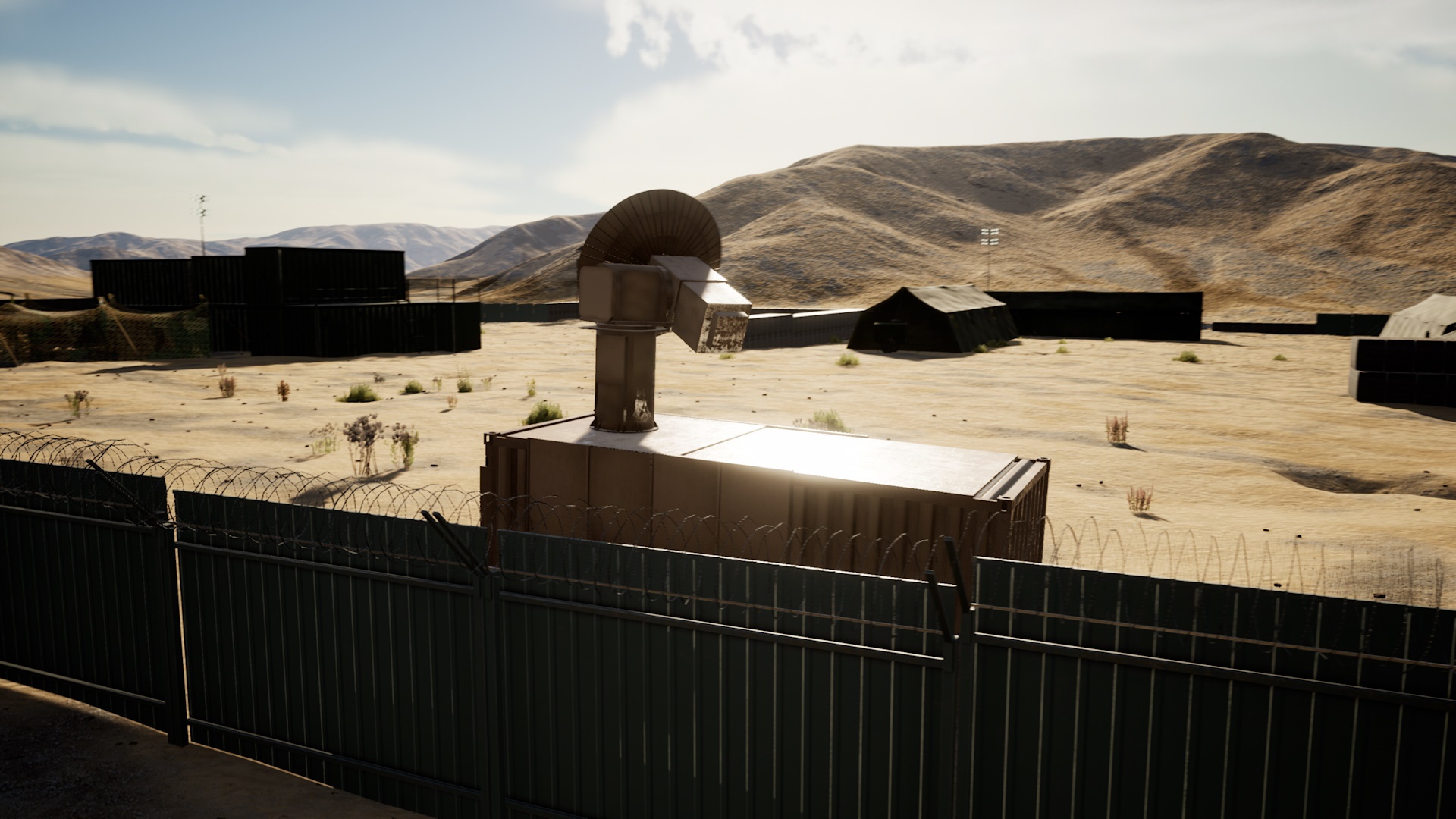
Credit: AFRL
Within the JCO construct, the US Air Force (USAF) has been given the lead role regarding electromagnetic and especially HPM weapons research. In February 2022 the Air Force Research Laboratory (AFRL) awarded Leidos, Inc. a contract to develop the Mjölnir, an advanced HPM C-UAV system. The project builds on an earlier technology demonstrator project designated THOR (Tactical High-powered Operational Responder) initiated in 2018. THOR was successfully tested by USAF against sUAV swarms, with primary testing taking place in New Mexico, and an expeditionary test which took place at an undisclosed location in Africa. Mjölnir will be a smaller but more potent system than THOR (which was housed in a 6 m container), using the same technology but adding important advances in capability, reliability, and manufacturing readiness. “Mjölnir will focus on creating a detailed blueprint for all future [C-UAV HPM] systems with enhanced range and technology for detecting and tracking” drones, said Adrian Lucero, THOR program manager at AFRL’s Directed Energy Directorate at Kirtland AFB, New Mexico. Leidos is expected to provide a Mjölnir prototype during FY 2023. Potential applications include defence of expeditionary military bases of all military services.
Hand-held, man-portable directed energy weapons promise to offer a flexible approach to close-range C-UAV missions. In shape, size, weight and operation, weapons such as DroneShield’s DroneGun resemble assault rifles or even large pistols. They generally require little training, and can be carried by infantry soldiers or military police in the field or on sentry duty. Batteries can be swapped out in the field, guaranteeing prolonged operational capability. Using high-performance directional antennas, they direct RF interference against UAVs. Disruption covers multiple frequencies simultaneously, and includes interference with guidance and satellite navigation channels, and also initiates immediate termination of video and data transmission from the UAV. A rotary dial on the weapon enables the selection of active jamming frequencies based on an assessment of the current threat. Major variants include the 7.3 kg DroneShield Tactical, and the DroneGun Mk 3 optimised for one-handed operation. Both are effective against a wide range of ISM bands as well as satellite navigation.
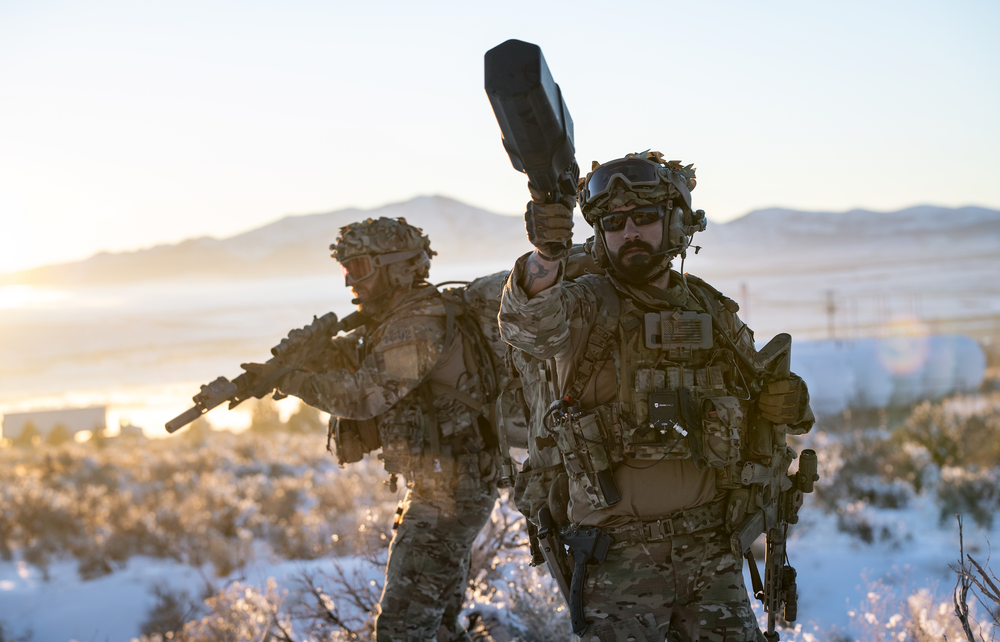
Credit: DroneShield
Laser Weapons
The various armed services and the joint service Defense Advanced Research Projects Agency (DARPA) are all pursuing HEL weapons capable of engaging UAVs as well as other airborne threats, ranging from artillery shells to cruise missiles and manned helicopters. While 300 kW to 1 MW power output are considered necessary to defeat sophisticated targets, an output in the 50-100 kW range is considered sufficient for disabling UAV. Current systems have demonstrated that capability.
The US Army’s Directed Energy Medium–Short Range Air Defense (DE M-SHORAD) system consists of an 8×8 armoured Stryker vehicle mounting a 50 kW class laser weapon. Named the ‘Guardian’, the system is suitable for the C-UAV and Counter-Rocket, Artillery, and Mortar (C-RAM) roles, as well as for engaging manned helicopters. A prototype platoon consisting of four vehicles is being fielded at Fort Sill, Oklahoma. The prototype platoon will be available for real-world deployments, but is primarily intended to inform the service’s ongoing DE M-SHORAD development and evaluation program. Currently under the aegis of the Army’s Rapid Capabilities and Critical Technologies Office (RCCTO), DE M-SHORAD is expected to transition to an acquisition program of record at the Program Executive Office (PEO) Missiles and Space in 2024.
Naval forces are pursuing the same general concepts as ground forces, with an emphasis on high-energy lasers (HEL) to either destroy UAVs or neutralise their sensors. Two leading naval projects are the HELIOS (High Energy Laser with Integrated Optical-dazzler and Surveillance) 60 kW laser and the ODIN (Optical Dazzling Interdictor, Navy). Both are shipboard weapons meant to defend the vessel against direct and indirect threats (such as target spotting for enemy ships) posed by UAVs. ODIN is conceived as a ‘dazzler’ to temporarily blind UAV sensors, while HELIOS aspires to physically down the unmanned aircraft. Helios combines a potentially destructive laser with a non-destructive dazzler to provide an array of options against UAVs and other threats.
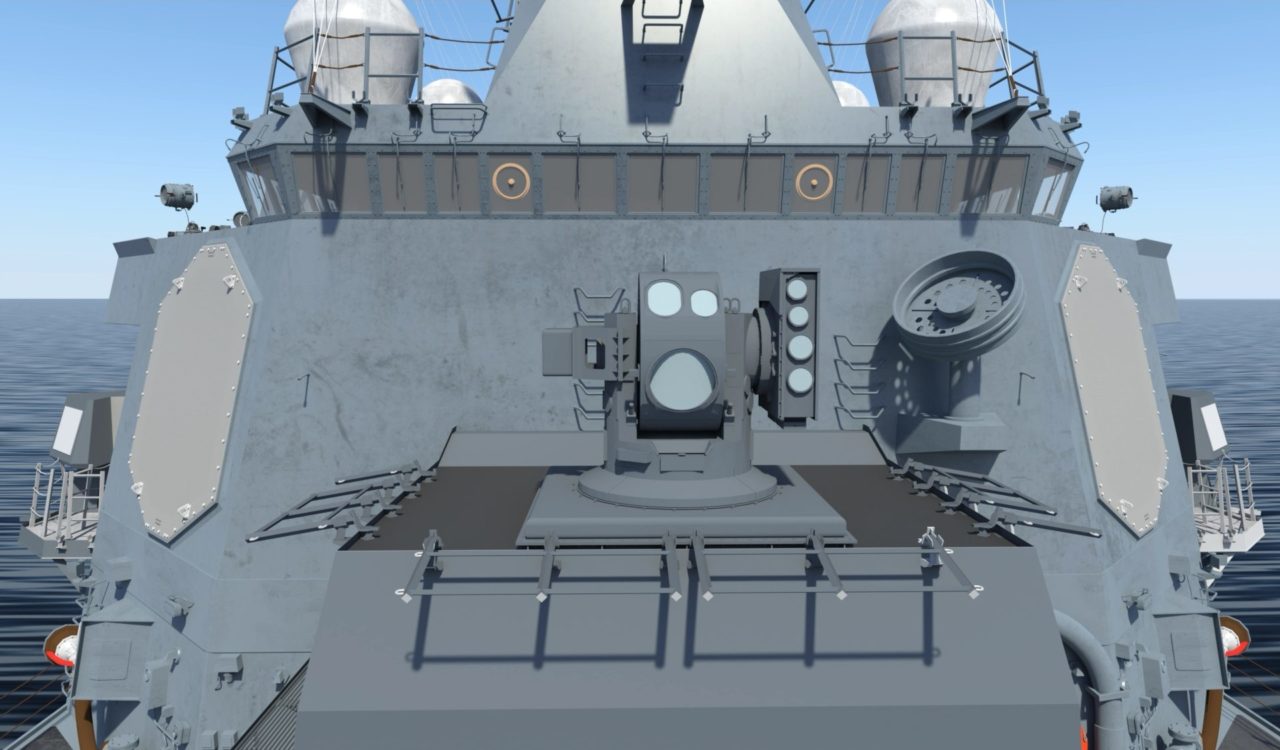
Credit: Lockheed Martin
The Navy’s Fiscal Year (FY) 2023 budget request defined ODIN as a “near term…shipboard Counter-Intelligence, Surveillance and Reconnaissance” capability specifically intended to dazzle UAVs and other ISR platforms. The Navy has to date deployed ODIN on seven Arleigh Burke class destroyers, with an eighth unit planned in FY 2023. A prototype HELIOS was installed on the Arleigh Burke class destroyer USS Preble in 2022 for fleet testing and sustainment, with the evaluation phase set to run through FY 2027.
Airborne Systems
Combat aircraft deploy air-to-air missiles to intercept large and medium unmanned aircraft. However, this is not practical for combatting smaller UAVs. There have been proposals for aircraft to be armed with laser or HPM weapons for the C-UAV role, but the technology is not considered sufficiently mature. Instead, a significant focus is currently placed at the lower end of the spectrum, adapting or designing ‘friendly’ UAVs for the short-range C-sUAV role.
Fortem Technologies’ DroneHunter F700 has been tested by the US Army which found it effective in defeating unmanned systems. It is a clean-sheet design specifically for the C-sUAV mission. It is equipped with six rotors for rapid ascent and manoeuvring. Target guidance is achieved via the firms proprietary SkyDome command and control software and Trueview R20 onboard radar. The F700 is optimised for defence of critical infrastructure has an operating range of 5 km. It can be deployed against Group 1 and Group 2 UAVs.
Intercept is achieved via NetGuns, a family of payloads mounted beneath the DroneHunter. NetGuns fire rapidly expanding nets to ensnare the target. Intercept of Class 1 drones is normally achieved by deploying a net which remains tethered to the F700, which then lowers the captured target to the ground where it can be secured and examined; the DroneHunter can tow drones weighing up to 6 kg. Larger, faster intruders are ensnared in a net which deploys a drogue chute to gently bring the drone down. Higher-flying weaponised drones can be intercepted as they descend on their terminal attack run. The AI-controlled DroneHunter operates autonomously, although a human operator can take over at any time.
The Modular Intercept Drone Avionics Set (MIDAS) developed by Aurora Flight Sciences with Department of Defense funding deploys bolos to foul the rotors of incoming sUAV. The fully autonomous MIDAS uses a radar feed to identify an oncoming threat, then switches to an AI-optical guidance system for the terminal intercept phase. The payload module beneath the MIDAS carries up to 16 ‘bolo’ projectiles for entangling the target’s propellers, enabling engagement of drone swarms or multiple single UAVs per mission.
Anduril’s autonomous area-defence system, which was acquired by the US Special Operations Command (USSOCOM) under a January 2022 contract, takes a more aggressive approach. The multi-component system can be easily set up in the field to protect critical infrastructure or expeditionary bases. The major components are the Sentry Tower and the Anvil UAV-based kinetic interceptor, both guided by the firm’s Lattice command and control operating system. The sentry tower is equipped with radar and optical sensors as well as processors to detect and classify Group 1-3 aerial targets at ranges of 2-15 km, depending on aircraft size. The Anvil interceptor is a UAV specially-shaped to withstand kinetic impacts with other UAVs, and is held ready in the Anvil launch box. Intercept is achieved through direct impact with the target; Group 1 and Group 2 UAVs are destroyed while leaving the Anvil interceptor UAV intact for further missions. Due to using no pyrotechnic or explosive components, Anvil is suitable for use by civilian operators.
Raising Standards and Standardisation
Going forward, the JCO is expected to produce a DoD directive on C-sUAV as well as a unified assessment of C-sUAV capabilities. The Pentagon also plans to establish a Joint C-sUAV Academy at Fort Sill, Oklahoma, under the aegis of the Army’s Fires Centre of Excellence. It will synchronise counter-drone tactics and training among the services. Programs will range from introductory level C-sUAV instruction for all servicemembers, over higher-level training for unit leaders, to expert-level training for specialised counter-drone operators. The academy is expected to reach initial operating capability during early Fiscal Year 2024, and full operation capability in 2025.
Sidney E. Dean







